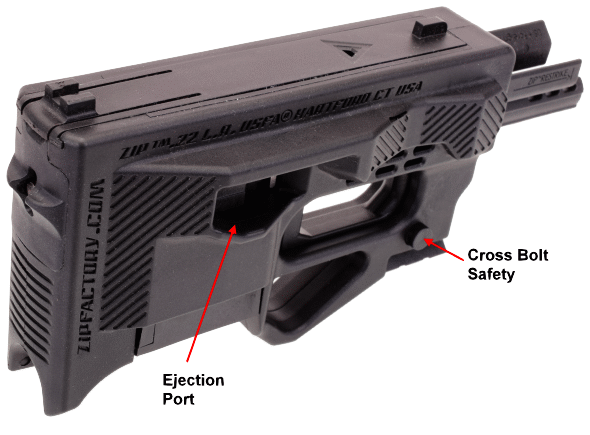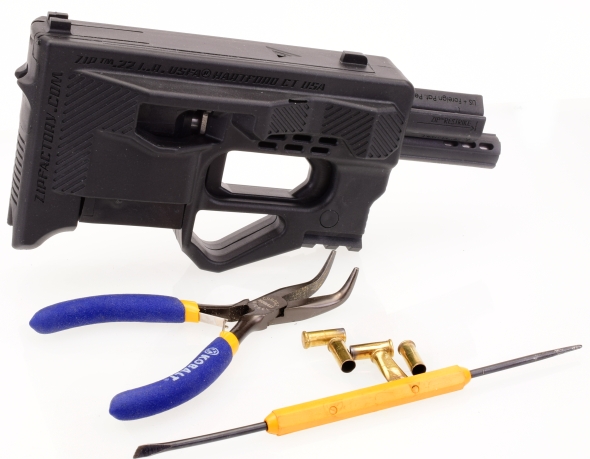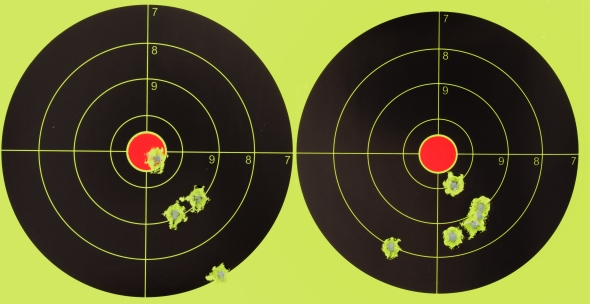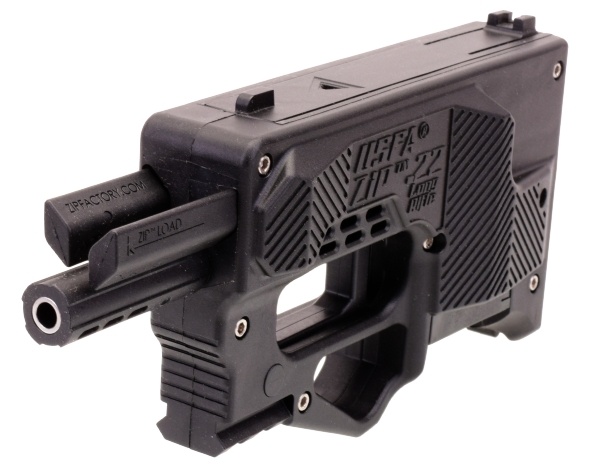With each passing year, there is an ever increasing need for me to exercise care when examining firearms that fall outside of my narrow… settled applications, interests and preferences. Subsequently, I have to spend more time understanding a company’s intent when they position a product for firearm consumers and then make sure I’ve designed an appropriate plan of assessment within that intent.

The ZiP™ .22 BASIC Black product is presented on the company’s web site with the following excerpts indicative of the overall presentation 1):
“The next generation of future weapons in a light, compact form factor. Simple in design, ZiP™ is a new Modular Weapons System, delivering amazing features with performance and upgradeability. With a near unlimited service life – you will experience The Future of Fun™ and a great day at the range. Camping, hiking, exploring the world – ZiP™ adapts to any mission”.
“Exceptionally affordable and with more features and functionality than any weapon ever delivered to date”.
” ZiP™ delivers a long sought after vision of “X-box” gamers and advanced weapon enthusiasts not possible until now. A futuristic weapons system where the unique arrangement of the principal components enables overall compactness and results in a new form factor.”
My interpretation of the product’s positioning is that USFA/ZiPFactory, LLC would like to tap into a market segment populated by video game enthusiasts who wish to extend their enjoyment of the digital firearms prevalent in shoot ’em up games to real firearms. I would guess the target demographic would be first time firearm buyers as I do not believe the ZiP™ would appeal to experienced owners of genuine modular weapons systems. I’ve arrived at this conclusion because accepting the company’s use of the word “amazing” in the context of performance and features of the ZiP™ would require a high degree of firearm naïveté and a general lack of firearm experience.
Further conjecture is that the company wants to create a culture surrounding a probably low margined firearm, in hopes that customers would develop into collectors who would go on to purchase highly margined accessories and rails. At the time of this writing there are 13 accessories and 9 rail options ranging in prices from $17.99 to $179.99. There is nothing wrong with the approach and it is not a new approach. Gillette has been heavily discounting razors with the hopes of future sales of razor blades since 1901. It is a wonderful thing when a company can create a product and market it creatively with profit as the objective but, in this case, is the product “The future of fun”?
Basic layout…
The pistol is a striker design. The Load Rod is depressed to charge the pistol from its magazine on initial loading. Yes, that really does put fingers ahead of the muzzle. In the event of a misfire, a second Restrike Rod has enough travel to recock the action without ejecting the misfire or attempting to draw another round from the pistol’s magazine.

The trigger feels like pulling the lever on a heavy duty industrial staple gun. Gummy, lots of creep and a measured 11 Lbs 3 Oz measured pull. The action can be decocked on a cleared and checked empty pistol by depressing either rod, squeezing the trigger and then easing the selected rod forward to its extended position. It may not serve to decock a loaded firearm, but it will prevent the rimfire firing pin from being damaged or damaging other parts through dry firing.
The breech block guide rod is stationary, but it is visible at the rear of the pistol. The sights are simple square notch, however, replacement top rails with a variety of configurations are available as accessories. The striker head is visible through the window just aft of the front sight.

The mag release is a push lever. The magazines are standard Ruger 10/22 type. The bottom rail is listed for use with a laser. The barrel’s fluted plastic shroud is visible from below. The magazine is awkward to remove and often hangs on its catch. Perhaps this problem would clear itself with more extensive use.

This is hold indicative of what happens when engineers design firearms without the auspices of adults. This is about the point where I got beyond, “This thing is kind of… cute” to “Who in the world set this geometry for a human hand? Yes, you can clutch the ZiP™ between two hands, left hand index finger clutching ahead and above the pistol’s cross bolt safety, but your right hand is still clutching the rear stub and the air. Personally, I was not left with the feeling that this firearm could be handled safely, despite its reported 5 safeties. The stub grip makes the two finger holds on the pistol natural places to grab on. Unfortunately, one of them is home to the trigger. The rods out front put fingers and hands too close to the muzzle when cocking or resetting the striker.
Too many manual pages, not enough nomenclature…
Perhaps a dozen or so pages of the manual are dedicated to handling and shooting instructions, the balance of the 54 pages are dedicated to instruction on clearing jams, restriking, approved ammunition lists, field disassembly, detail disassembly, and lots of drawings referencing 3 non-specific parts as a modular group. To me, if related piece parts do not stay together as a stand alone assembly when removed, they are not a modular group, they are simply related piece parts. There is a lot of touting of the design of the ZiP™ and the non-standard approaches taken; to me, an exercise in the selection of poor alternatives to established designs in an effort to solve a myriad of non-existing problems.

The ZiP™ is easy to take apart and to reassemble, but I am not sure why anyone would want to do so with any routine. There is inference on the product site and in the manual that upgrades and more accessories will become available, so I assume the desire is to make owners think there is a benefit to tinkering with the product on a continual basis. Some of my favorite handguns are routinely cleaned through 20,000 rounds of ammo before being disassembled for cleaning and even then I really don’t get excited about stripping firearms. The idea is to shoot them, make them useful, not tinker with them.

How about performance?
Following the firearm’s manual, using ammunition as specified by the company matched with the recommended spring I had more jams that I have ever had with any firearm no declared broken. I was unable to get through Remington, Federal, CCI or Winchester ammo without experiencing 2 – 3 failures with each 10 round magazine full. Changing magazines did not alter the outcome and clearing jams was a bear. Below, what came to be my ZiP™ shooting kits.

The dominant failure was an empty casing not ejecting and dropping under the breech block guide rod while a fresh round was started into the pistol’s chamber. The case would wedge tight, trapping the loaded round between the magazine and chamber. The jammed empty case did not want to cooperate and drop out, the magazine could not be withdrawn with the fresh round trapped part way in transfer and it is an exceptionally awkward pistol to operate; shooting or clearing jams.

The targets above were shot as 10 yards with a supported two hand hold. CCI 40 grain right 1 1/4″, Federal 40 grain left; the 5th shot was low and off the target 3″. These were the two best targets shot. Part of the problem could have been caused by loss of concentration from clearing jams. All shots should have been in the ten ring from that distance.
| Manufacturer | USFA/ZiP Factory, LLC. US |
| Model | ZiP .22 BASIC Black |
| Type | Blow Back – Semi Auto Striker |
| Material | Black Poly Housing |
| Caliber | .22 LR |
| Capacity | 10 |
| Barrel Length | 5 1/4″ |
| Sight Radius | 4 1/2″ |
| Overall Length | 8″ |
| Overall Height | 3 3/4″ |
| Width | 1 3/4″ |
| Empty Weight | 1 Lb 1 Oz |
| Trigger pull | 11 Lbs 3 Oz. |
| UPC | 896213002852 |
| MSRP | $219.99 |
|
Actual Weights and Measures |
|
Conclusions
It is not easy to design innovative products, particularly when their appearance is a bit… provocative, but in my opinion, this one was not refined enough to be sold at the time this was written. Foremost, a firearm needs to be safe and it needs to fire reliably. For me, the shape of the firearm and the presence of recoil rods extending to nearly the pistols muzzle, make unsafe handling a sin easy to commit. Jams at some level are to be expected from almost any .22 LR autoloader, but this pistol jammed to the extent of being a major reliability problem and it is way too sensitive to ammunition type. Again, I think the problem is the designer attempting to control cycling with predominately tuned spring tension rather than velocity dampening reciprocating mass. A similar issue causes short barrel centerfire autoloaders with slides sometimes difficult to make reliable.

It is baffling why a firearm manufacturer could name a product a ZiP Gun, especially a company operating out of a state like Connecticut that has such egregious gun laws. A zip gun is a long standing term that defines amateurishly fabricated firearms usually associated with criminal behavior.
There are many innovations that can be found in the ZiP, but none I can see that advanced firearm performance, size, human engineering, or durability. The pistol’s accuracy is mediocre, it handles poorly. I don’t think this product is even particularly low in price. My opinion is that this would make a terrible first firearm and a poor way to move young shooters from video games, safe toys, to the world of lethal firearms. That is my considered opinion.

Email Notification